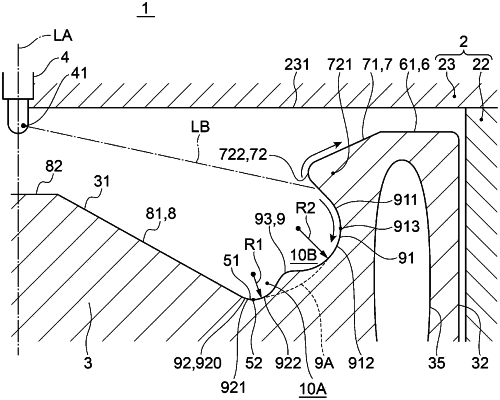| CPC F02F 3/28 (2013.01) | 7 Claims |

|
1. A piston of an internal combustion engine configured to be reciprocable along an axial direction in a cylinder, comprising:
a cavity formed to be recessed in a center of a piston top surface; and
an outer circumferential edge portion located on a radially outer side of the cavity in the piston top surface,
wherein the cavity includes:
a lip portion which has an inclined surface extending obliquely downward from the outer circumferential edge portion toward a radially inner side;
a raised portion protruding upward from a bottom of the cavity; and
a curved portion connecting the raised portion and the lip portion, and
wherein the curved portion includes:
an outer circumference-side curved surface which includes a curved surface connected to the lip portion;
an inner circumference-side concave surface which is located on the radially inner side of the outer circumference-side curved surface and includes a surface connected to the raised portion, the inner circumference-side concave surface including a deepest portion of the cavity; and
a convex surface formed between the outer circumference-side curved surface and the inner circumference-side concave surface, as well as protruding upward, and
wherein an inner circumferential end of the lip portion is disposed radially inward relative to a maximum inner diameter portion of the outer circumference-side curved surface,
wherein the inner circumference-side concave surface includes an inner circumference-side curved surface curved downward into a concave shape, and
wherein the inner circumference-side curved surface is configured to have a larger curvature than the outer circumference-side curved surface.
|